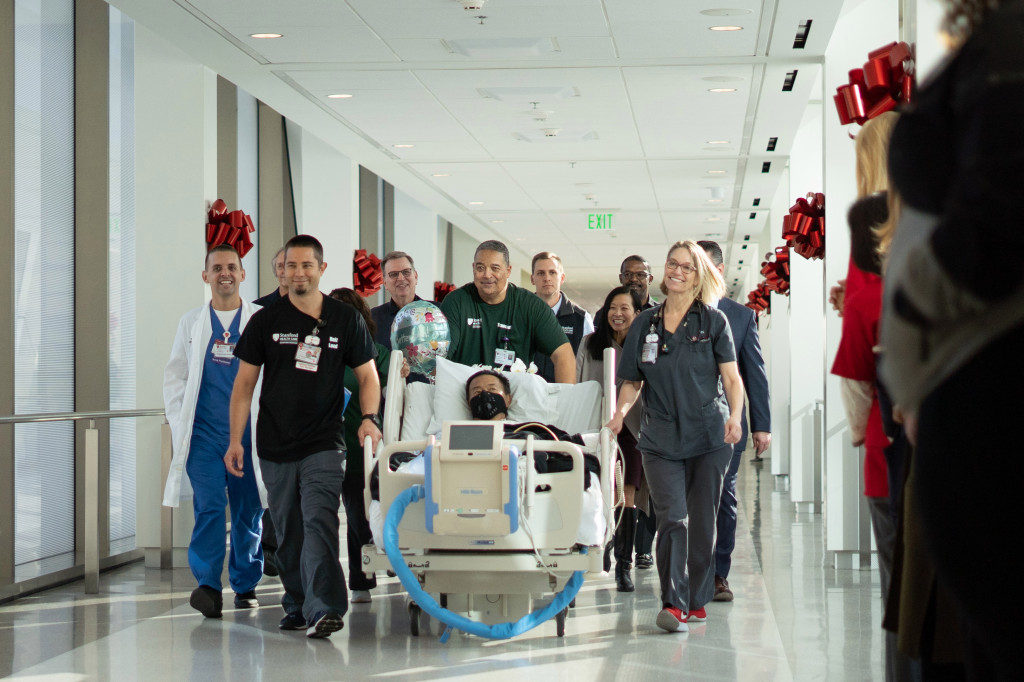Click here if you’re unable to view the photo gallery on your mobile device.
STANFORD — It felt like an Apple Store opening.
Sunday marked the first day of operation for the new Stanford Hospital, a $2 billion, seven-story facility spilling over with the modern, clean, light-filled design ethos endemic to Silicon Valley, and the energy was palpable.
Some workers lined the sides of the sky bridge connecting the original hospital with the new one, and dozens of others of staffers and board members looked on eagerly nearby.
As the very first patients to be transferred to the new facility came through, escorted by a throng of clinicians, staff, and hospital officials, applause broke out, people cheered, and some called out “Welcome to 500!,” referencing the new hospital’s address on Pasteur Drive.
“This is like the Ritz-Carlton,” patient Thomas Miller, 66, of Riverbank, said while lying in his hospital bed, as natural light from a huge window overlooking the trees and mountainsides of the Peninsula shone into his room.
A couple of patients sat up in their rolling beds to video-record their grand entrances on their smartphones, while one extended his left arm to put up a peace sign as those watching encouraged him, like a rock star floating back to the stage after a stage dive.
Though hospitals are not typically places of excitement, finally letting patients experience the massive monument to cutting edge health care that has been in the making for more than a decade warranted a celebration, officials said.
“You need to have a big party for it,” David Entwistle, the president and CEO of Stanford Health Care said.
“It was really a sense of excitement,” Entwistle said about the official opening. “I was thinking, ‘Wow, we finally accomplished something that is an incredible milestone for not only what we can do for our patients, but really for the community, and even for Stanford Campus.’”
The 824,000-square-foot facility includes 368 single-patient rooms, as opposed to the older facility’s double-occupancy rooms, as well as a 76-bay trauma center, and 20 modern operating rooms.
Hospital officials said the whole facility was built from the ground up with patients and their loved ones in mind, including over 1,000 planning meetings to get all the details right, and it shows.
Miller was one of the first patients to be transferred, and is currently recovering from surgery to remove a tumor in his pancreas. Due to a previous condition in his inner ear, he said he gets claustrophobic easily, but doesn’t feel that way in the spacious room at the hospital.
“I’ve traveled a lot being in sales,” Miller said. “Some of those hotels can be pretty dank.”
But in his Stanford room, “I’ve got a large screen TV, a walk-in shower,” he said. He also loves the electronic remote controls of the window shades at his fingertips, and said the entire staff has been “Johnny on the spot” with anything he has needed.
And in addition to patients, Stanford dedicated the entire third floor of the facility to the well-being of patients’ family members, caregivers, loved ones, and the staff.
The roughly four acres of outdoor gardens and walking paths, specked with benches, chairs, and tables, offers people a “kind of contemplative place…where they can be away from sometimes the very busy, stressful environment of where care is actually being delivered,” Alpa Vyas, the vice president of patient experience at Stanford Health Care, said Sunday.
“Typically, nobody wants to be in the hospital,” Vyas said. “And when you are, control of everyday life can often go away.”
So part of the hospital’s design, that connect the outdoors and inside, and the large arrays of colorful artwork that adorn walls and pathways all around the facility help “bring some level of normalcy to a situation that isn’t always normal,” Vyas said.
The third floor also features an interfaith chapel, and a caregiver resource center where health librarians can do custom research for a patient and their family to help provide supplemental information to them about a new diagnosis or condition they may be dealing with, Vyas said.
Over the next four to five years, the original hospital will be seismically upgraded, renovated, and much of it will be converted into a cancer-focused facility, while the former emergency department there transitioned to a pediatric unit as of Sunday, officials said.
Entwistle, the CEO, said two years of planning went into ensuring the transition day went smoothly, and officials said over 1,500 staff members were on hand to help.
Vyas said as the calendar drew closer to Sunday, anticipation was growing among the hospital’s many teams, for what is often a once-in-a-career chance to open a brand new facility.
“Because so many people have worked on the project for quite some time,” Vyas said, “to see it come to fruition, it’s pretty exciting.”










